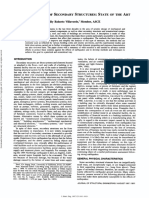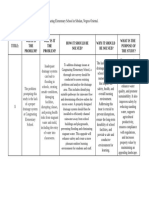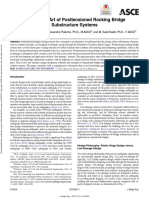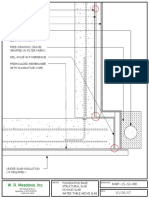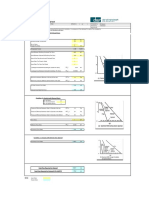Evaluation and Repair of A Distressed Masonry Veneer Façade: A Case Study of The Litton Reaves Repair Project
Evaluation and Repair of A Distressed Masonry Veneer Façade: A Case Study of The Litton Reaves Repair Project
Uploaded by
mtCopyright:
Available Formats
Evaluation and Repair of A Distressed Masonry Veneer Façade: A Case Study of The Litton Reaves Repair Project
Evaluation and Repair of A Distressed Masonry Veneer Façade: A Case Study of The Litton Reaves Repair Project
Uploaded by
mtOriginal Title
Copyright
Available Formats
Share this document
Did you find this document useful?
Is this content inappropriate?
Copyright:
Available Formats
Evaluation and Repair of A Distressed Masonry Veneer Façade: A Case Study of The Litton Reaves Repair Project
Evaluation and Repair of A Distressed Masonry Veneer Façade: A Case Study of The Litton Reaves Repair Project
Uploaded by
mtCopyright:
Available Formats
Downloaded from ascelibrary.org by University of California, San Diego on 02/21/16. Copyright ASCE.
For personal use only; all rights reserved.
Evaluation and Repair of a Distressed Masonry Veneer Façade: A Case Study
of the Litton Reaves Repair Project
J. E. Peterson1 and T. Shelton2
1
Whitlock Dalrymple Poston & Associates, P.C., 10621 Gateway Boulevard, Suite
200, Manassas, Virginia 20110; PH (703) 257-9280; FAX (703) 257-7589; email:
epeterson@wdpa.com
2
Viginia Polytechnic Institute and State University, 90 Sterrett Facilities Complex,
Blacksburg, Virginia 24061; PH (540) 231-4076; email: sheltont@vt.edu
ABSTRACT
The Litton Reaves facility is a multi-use laboratory and classroom building for the
Animal Science Department of Virginia Tech. Constructed in the early 1980s, the
facility had been in service for almost 20 years before symptoms of distress began to
appear in the exterior cladding of the building. The severity of the distress was
punctuated by the partial failure of a section of oolitic limestone panel that fractured
and had to be removed from the facility. This case study offers an overview of the
evaluation performed on the exterior cladding system of the building and discusses
the mechanisms that led to the problems in the brick and limestone veneer. The paper
discusses the repair program and highlights several structural repair and sequencing
challenges that were encountered due to the redistribution of forces within the veneer.
Correction of nagging water penetration and air infiltration problems were sequenced
and performed in conjunction with the structural repairs in order to improve the
building’s interior conditions while meeting the University’s “design-to” budget.
INTRODUCTION
The Litton Reaves facility is a three story building on the campus of Virginia Tech
consisting of a combination of classrooms, office spaces and laboratory facilities
(Figure 1). In August of 1999, a portion of one of the limestone panels fractured,
became loose and consequently had to be removed from the building for safety
purposes. A preliminary review of the exterior cladding by University personnel
identified other areas of similar distress throughout the façade including displaced
and cracked exterior brick masonry, cracked and spalled limestone panels, displaced
interior slabs, cracked concrete masonry interior walls and other cladding related
problems throughout the facility. The University undertook an initial repair program
to stabilize some of the limestone by installing threaded steel rods set in high-strength
epoxy at displaced or cracked panels. Ultimately, a more in-depth investigation was
undertaken to determine the underlying causes of the distress. Repairs were then
85
Copyright ASCE 2009 Forensic Engineering Congress 2009
Forensic Engineering 2009
86 FORENSIC ENGINEERING 2009
Downloaded from ascelibrary.org by University of California, San Diego on 02/21/16. Copyright ASCE. For personal use only; all rights reserved.
designed to restore the integrity and support of the building’s exterior façade while
maintaining occupancy of the facility.
Figure 1. Litton Reaves front elevation.
BUILDING EVALUATION
The Litton Reaves building was constructed with a reinforced concrete frame
founded on concrete caisson foundation systems. The exterior skin of the building
consisted of brick veneer with bands of limestone panels and limestone window
surrounds. The exterior veneer was supported by concrete grade beams spanning
between the caissons at the first floor level and by structural steel angles connected to
embedded plates at each floor line. Limestone window surrounds were supported on
the exterior perimeter beams and clipped to the concrete with bolted steel angles.
Figure 2 shows a typical elevation and wall section for the building at the window
stack.
Copyright ASCE 2009 Forensic Engineering Congress 2009
Forensic Engineering 2009
FORENSIC ENGINEERING 2009 87
Downloaded from ascelibrary.org by University of California, San Diego on 02/21/16. Copyright ASCE. For personal use only; all rights reserved.
Figure 2. Typical building section and window detail.
The evaluation of the building generally consisted of a visual survey of the facade
distress, probe openings at critical points of lateral and vertical restraint, water testing
of exterior brick veneer and window systems, non-destructive testing of structural
framing systems and material testing of façade components. The brick was found to
be of generally good quality with little to no evidence of durability problems that
would require a complete recladding. Localized areas of distress such as through-
brick cracks and spalls were observed sporadically at the shelf angle locations and
building corners. The condition of the brick at the upper floors was appreciably
worse with visible cracking and out-of-plane displacement. The masonry mortar
exhibited some minor shrinkage cracking, but otherwise appeared to be in reasonably
good condition in most areas of the building. Occasional voids in the head joints
were observed in probe openings which, combined with the shrinkage cracking,
contributed to moderate rates of water penetration.
During the inspection of the limestone panels, the anchors for lateral restraint were
found to be incorrectly installed into oversized holes in the panels that were not filled
with mortar as recommended by the Indiana Limestone Institute. This permitted
excessive free play of the panel connections prior to engaging the lateral restraint and
allowed many of the panels to displace out-of-plane. The brick masonry veneer ties
were located non-destructively using a pachometer (ferrous metal detector). The
spacing between ties was somewhat inconsistent and there were large areas where no
ties were detected, such as at the corners of the building. Random probe openings
indicated that the galvanized ties displayed very little corrosion, even after 25 years
of service; however, because the tie spacing was often excessive, parts of the
masonry veneer were not adequate to resist the design lateral loads. Both the
Copyright ASCE 2009 Forensic Engineering Congress 2009
Forensic Engineering 2009
88 FORENSIC ENGINEERING 2009
Downloaded from ascelibrary.org by University of California, San Diego on 02/21/16. Copyright ASCE. For personal use only; all rights reserved.
limestone panels and the brick veneer would require supplemental lateral restraint to
stabilize the veneer.
The original design did not include horizontal expansion joints below the shelf angles
to accommodate expansion of the veneer as is required in current industry
recommendations. Distress resulting from restrained differential movement was
obvious and widespread. Frame shortening combined with clay brick moisture
expansion had taken a severe toll on the structural integrity the cladding. Based on
coefficients of volume change for these conditions, maximum relative displacements
for the veneer were likely as much as 1” with almost 1/2” at the mid height shelf
angles. Figure 3 schematically depicts this phenomenon and the resultant distress.
Displacement of
brick and limestone
Figure 3. Schematic illustration of relative movement for brick veneer over a
concrete frame and resultant displacements of brick and limestone.
The horizontal legs of the masonry shelf angles were typically set in contact with the
brick below, developing internal stress as the veneer expanded into the bottom of the
angle. This was most evident where hard plastic shims were found between the shelf
angle and the brick below, likely to level the shelf angle. Because the shims were
never removed, the compressive stresses formed between the angle and the brick
crushed and split the plastic shims, leaving an indentation from the brick cores. The
masonry veneer below the two plastic shims was also cracked due to the stresses
generated. The original design specified bolted connections between the shelf angle
and the embedded angle. However, due to irregularities in the concrete slab edges,
the original bolted connection was often abandoned and the angle was welded either
along the heel of the angle or along the toe of the vertical leg. Where the veneer
came in contact with the shelf angles, the forces created by the restrained movement
Copyright ASCE 2009 Forensic Engineering Congress 2009
Forensic Engineering 2009
FORENSIC ENGINEERING 2009 89
Downloaded from ascelibrary.org by University of California, San Diego on 02/21/16. Copyright ASCE. For personal use only; all rights reserved.
cracked and spalled the masonry and limestone, or in some cases, distorted bolts and
fractured the welds of the supporting elements. With the connection to the building
severed, the masonry above the shelf angle became predominantly supported by the
masonry below, thus increasing the internal stresses on the veneer of the lower levels
(Figure 4).
Figure 4. Restrained movement in brick veneer and resulting damage.
Clockwise from top right 1) broken weld connection behind angle; 2)
overstressed bolts with deformed washers; 3) rotation of shelf angle and
cracking of mortar joints; 4) crushing of embedded shims with indentations
from brick cores.
Copyright ASCE 2009 Forensic Engineering Congress 2009
Forensic Engineering 2009
90 FORENSIC ENGINEERING 2009
Downloaded from ascelibrary.org by University of California, San Diego on 02/21/16. Copyright ASCE. For personal use only; all rights reserved.
Limestone panels installed at the roof elevation were constructed to bear on a
galvanized plate with a toe bar welded to the leading edge at the top of the spandrel
beam. The inside face of the panel was notched at the bottom to receive the lipped
plate connection, but no mortar was installed between the stone and the steel. On
many of the panels, the front edge was observed bearing directly on top of the panel
below and the panel was completely disengaged from the bearing connection. This
condition resulted in fractured welds at the support points and spalling on the interior
face of the panel from the masonry expansion (Figure 5).
Figure 5. Condition of limestone panels at supports and broken weld on support
plate.
In addition to the structural deficiencies noted in the façade, several serviceability
problems were observed in the exterior wall system. Significant air infiltration
through the building envelope was apparent while walking through the hallways on
windy days that originated from the window systems and ceiling plenums. Severe air
exfiltration was observed from the masonry cavities on the exterior due to positive
building pressurization and an incomplete air/moisture barrier for the building. A
study of the drawings and the interior plenum spaces above the drop ceilings
indicated that there were large areas where air could migrate into the cavity of the
veneer from behind the limestone panels and around the windows and doors.
Copyright ASCE 2009 Forensic Engineering Congress 2009
Forensic Engineering 2009
FORENSIC ENGINEERING 2009 91
Downloaded from ascelibrary.org by University of California, San Diego on 02/21/16. Copyright ASCE. For personal use only; all rights reserved.
Flashings were often terminated at the limestone window surrounds and other
interruptions without end dams and were held back from the exterior face of the
brick. The sections of the through wall flashing spanning the wall cavity were filled
with mortar and often sagged in the cavity, which inhibited the drainage of water.
Coping stone flashings were not terminated correctly on the leading edge, nor were
they tied into the roof membrane on the back side of the parapet (Figure 6). Because
of these deficiencies, testing was performed on the masonry in accordance with
ASTM C1601, “Standard Test Method for Field Determination of Water Penetration
of Masonry Wall Surfaces” to determine how much water would be expected to
penetrate the veneer during a severe rain event. The testing revealed that the veneer
was relatively permeable and would experience significant volumes of water in the
cavity during periods of heavy wind driven rain. Thus, the condition of the flashing
system was critical to the overall performance of the wall system and would have to
be repaired.
Figure 6. Poorly installed flashing including shelf angles with missing end dams
and cavity.
Sealants installed around windows, between brick and limestone, at limestone panel
joints, at window perimeters and at capstone joints had all failed. The sealant texture
was hard and brittle, and sealant was often cracked or extruded from the joints at
material transitions due to expansion of the veneer. The sealants on the building
appeared to be original, indicating that they have been in service for approximately
25 years, far beyond the anticipated service life of most sealant materials. Because
there were no secondary barriers to water penetration, failures of these sealants
allowed water to enter directly into the building through limestone panels above the
window heads. Water damaged fiberglass insulation and water staining on the ceiling
tiles were observed at several locations above and around the windows (Figure 7).
Copyright ASCE 2009 Forensic Engineering Congress 2009
Forensic Engineering 2009
92 FORENSIC ENGINEERING 2009
Downloaded from ascelibrary.org by University of California, San Diego on 02/21/16. Copyright ASCE. For personal use only; all rights reserved.
Figure 7. Failed panel sealant joints and resultant leakage over windows.
Water tests performed on the operable windows in accordance with ASTM E 1105,
“Standard Test Method for Field Determination of Water Penetration of Installed
Exterior Windows, Skylights, Doors, and Curtain Walls, by Uniform or Cyclic Static
Air Pressure Difference” resulted in severe water penetration into the building. The
leakage was the result of failed internal sealants, worn glazing and sash gaskets and
ineffective weep components. Since refurbishing the windows would only solve a
portion of the leakage issues during severe weather events, it was recommended that
the windows be replaced.
REPAIR PROGRAM
Based on the findings of the forensic investigation, the University initiated a repair
program for the building. Since funding for the program was limited, and the
building was to remain occupied during the restoration, a re-cladding scenario was
ruled out and a selective repair program was initiated. The repairs were prioritized
based on the funds available to correct the structural deficiencies first, with the
remaining funds used to improve the serviceability problems such as water
management and energy losses. The program objectives were as follows:
• Re-establish reliable support of the veneer at each floor level;
• Relieve the stresses currently stored in the building façade;
• Provide for additional future movements from any residual long-term
expansion and cyclic thermal movements;
• Improve the water management capability of masonry flashings and weep
systems;
• Reduce the water penetration through the masonry veneer and limestone
panels; and
• Replace the existing window systems throughout the building.
Coincidentally, a new stone masonry building was slated to be constructed directly
adjacent to the Litton Reaves facility that would share the loading dock space and
have a common wall in the southeast corner of the building. Both construction
projects shared work areas and lay-down space, which required careful sequencing of
Copyright ASCE 2009 Forensic Engineering Congress 2009
Forensic Engineering 2009
FORENSIC ENGINEERING 2009 93
Downloaded from ascelibrary.org by University of California, San Diego on 02/21/16. Copyright ASCE. For personal use only; all rights reserved.
the work to prevent delays to both projects. The most significant challenge was to
maintain operations in the facility during construction. Primary and emergency
egress points had to be maintained at all times throughout construction. Lighted
sidewalk sheds were designed to provide protection from potential overhead hazards
from the distressed cladding and were erected two years prior to construction. The
same systems were also designed and utilized to isolate and protect the pedestrians
from the construction operations and support the scaffold systems during
construction.
As the work was to be done with the veneer in place, the repairs were sequenced to
incrementally reduce the load in the facade while establishing new connections to the
building frame. This was performed by working in a “top down” approach on the
building. Existing shelf angles were removed in sections while shoring each floor of
masonry (Figure 8).
Figure 8. Shoring of existing masonry after replacement of shelf angle sections.
Because of lead based paint on the structural steel, and asbestos mastics found on the
existing flashing materials, shelf angles were replaced with new galvanized steel
angles bolted into the existing concrete frame. Angles were mounted to create room
for future expansion and contraction of the floors below and new flashing elements
were installed with hemmed drip edges and end dams at each floor to improve the
water management system. After isolating and re-supporting the masonry at the top
shelf angle, the process was repeated sequentially on the floors below.
The limestone panel systems around the entire perimeter of the building at the third
floor and parapet levels were temporarily removed from the building to obtain access
to the damaged supports. Removal of the panel systems was complicated by the fact
that the building envelope was breached at each window by the removal of the
limestone panels that served as the primary weather resistive barrier in these locations
(Figure 9). Building occupants were temporarily relocated while the panels were
removed and the repairs were performed in the area. The removal of the panels to
repair the supports also facilitated access to the most severe air infiltration points and
allowed for supplemental sheathing and framing to be added behind the limestone in
order to seal the gap between the window head and the slab above. Once the closure
panel was installed, the building occupant was free to re-occupy the office. The
Copyright ASCE 2009 Forensic Engineering Congress 2009
Forensic Engineering 2009
94 FORENSIC ENGINEERING 2009
Downloaded from ascelibrary.org by University of California, San Diego on 02/21/16. Copyright ASCE. For personal use only; all rights reserved.
entire process took approximately 3 days per window to complete from beginning to
end and the impact to the office occupant was minimized where possible.
Figure 9. Removal of limestone panel exposing breach in exterior envelope and
installation of envelope closure panels.
To reduce the amount of water penetration through the veneer, the mortar joints of
the entire masonry exterior were tuck-pointed. This also permitted the repair of the
existing masonry cracks and allowed the mortar from the repairs to the shelf angles to
be replaced with the tuck-pointing, resulting in a more uniform appearance of the
building façade. Because of the unusual color of the original brick, a suitable
replacement could not be obtained to install where the brick could not be salvaged.
Even with an approximate 80% salvage rate, new brick would be required to be
blended with the old in most areas of the building. A decorative plaza perimeter wall
constructed with an identical brick to the main building was demolished and the brick
was salvaged to be used on the building in order to make replaced brick less
noticeable.
After the project was underway, the University elected to replace all the windows in
the facility as a supplemental project that ran concurrently with the repairs to the
cladding. A thermally broken heavy commercial window system with low E glass
was installed to further improve the energy efficiency of the building. This work was
sequenced into the phasing of both the repair project and the newly constructed
facility adjacent to Litton Reaves.
After the repair project and the window installation were complete, the University
elected to stain the brick masonry to allow it to blend aesthetically with the stone
masonry buildings in the vicinity, including the new building with which it shared a
loading dock. The completed exterior facade is shown in Figure 10.
Copyright ASCE 2009 Forensic Engineering Congress 2009
Forensic Engineering 2009
FORENSIC ENGINEERING 2009 95
Downloaded from ascelibrary.org by University of California, San Diego on 02/21/16. Copyright ASCE. For personal use only; all rights reserved.
Figure 10. Elevations of Litton Reaves after installation of masonry stain.
CONCLUSION
The project was completed in 2008. The University spent approximately 2.9 million
dollars on the renovation which was performed on-schedule, under budget, and with
minimal disruption to the building occupants. Since the renovation, the water leakage
observed through exterior walls and window systems was eliminated and the severe
air infiltration experienced during the winter months was significantly reduced. On
the exterior, the improvements made to the lateral and vertical support conditions,
coupled with the new horizontal and vertical movement joints installed, allow the
veneer to expand and contract without developing the internal stresses that led to the
previous cladding failures. Recent exterior surveys of the building indicate that the
lateral and vertical displacements have been arrested and there is no evidence of
distressed veneer or masonry cracking. Overall, the Litton Reaves Repair project
demonstrates how significant serviceability and energy efficiency improvements can
be implemented into a structural and architectural repair program without imparting
substantial additional costs to the project.
REFERENCES:
Indiana Limestone Institute of America, Inc., Bedford, Indiana
Brick Industry Association Technical Notes 18 and 18A (2006). “Volume Changes –
Analysis and Effects of Movement.” Brick Institute of America, Reston, Virginia
ASTM International, West Conshohocken, Pennsylvania
Copyright ASCE 2009 Forensic Engineering Congress 2009
Forensic Engineering 2009
You might also like
- ASTM C1063-12a - Standard Specification For Installation of Lathing and Furring To Receive Interior and Exterior Portland Cement Based Plaster PDFDocument12 pagesASTM C1063-12a - Standard Specification For Installation of Lathing and Furring To Receive Interior and Exterior Portland Cement Based Plaster PDFibrahim100% (2)
- Corrosion of Steel in Concrete - Investigation and AssessmentDocument16 pagesCorrosion of Steel in Concrete - Investigation and AssessmentماقوريNo ratings yet
- AAMA 2410-03: Standard Practice For Installation of Windows With An Exterior Flush Fin Over An Existing Window FrameDocument9 pagesAAMA 2410-03: Standard Practice For Installation of Windows With An Exterior Flush Fin Over An Existing Window FrameGino TironiNo ratings yet
- Neufert Architects DataDocument648 pagesNeufert Architects DataShalom Araya100% (5)
- PRPC324 Module 5Document40 pagesPRPC324 Module 5holeeshet holeeshetNo ratings yet
- Drainage Systems in Retaining WallsDocument9 pagesDrainage Systems in Retaining WallsAlex Tituaña100% (2)
- Yura Bracing SlidesDocument7 pagesYura Bracing SlidesSakisNo ratings yet
- Pipe - Culvert Design PDFDocument1 pagePipe - Culvert Design PDFDarshan M T100% (1)
- Forensic Engineering 2018Document9 pagesForensic Engineering 2018Roy Monteagudo VeneroNo ratings yet
- Villaverde, Roberto - 1997 - Seismic Design of Secondary StucturesDocument9 pagesVillaverde, Roberto - 1997 - Seismic Design of Secondary StucturespvecciNo ratings yet
- Baci Galupo 2012Document23 pagesBaci Galupo 2012Sujan TripathiNo ratings yet
- Retrofitting JournalDocument4 pagesRetrofitting JournalprashanthNo ratings yet
- Rehabilitation of Reinforced Concrete ColumnsDocument7 pagesRehabilitation of Reinforced Concrete ColumnsalaaNo ratings yet
- Anatomy of A DisasterDocument11 pagesAnatomy of A DisasterYeimiNo ratings yet
- The Behaviour of Structures in EarthquakesDocument2 pagesThe Behaviour of Structures in EarthquakesmelplaNo ratings yet
- Seismic Design of Secondary Structures State of The ArtDocument9 pagesSeismic Design of Secondary Structures State of The ArtSatinNo ratings yet
- Repair and Rehabilitation of StructuresDocument5 pagesRepair and Rehabilitation of Structuresfiras safieddineNo ratings yet
- Lessons Learnt From Building Damages in The Wenchuan EarthquakeDocument9 pagesLessons Learnt From Building Damages in The Wenchuan EarthquakeNur AthirahNo ratings yet
- Nuclear Engineering and Design: A A A B BDocument12 pagesNuclear Engineering and Design: A A A B BAssia Ben AhmedNo ratings yet
- Case Studies in Structural Repair of Pretensioned Concrete ProductsDocument6 pagesCase Studies in Structural Repair of Pretensioned Concrete Productsmekkawi6650No ratings yet
- Influence of Polymers On Concrete Damping Properties: S.F. NabaviDocument6 pagesInfluence of Polymers On Concrete Damping Properties: S.F. Nabavi배배No ratings yet
- Fenton DamDocument8 pagesFenton DamMariam ElgaSemyNo ratings yet
- 1 s2.0 S0141029622016194 MainDocument16 pages1 s2.0 S0141029622016194 MainHibretu Kaske KassaNo ratings yet
- Dynamic Testing of Reinforced Concrete Beams Damaged and Repaired With Fiber Reinforced Polymer SheetsDocument7 pagesDynamic Testing of Reinforced Concrete Beams Damaged and Repaired With Fiber Reinforced Polymer SheetsVladekNo ratings yet
- Seismic Performance of Precast Slab To Beam Connection: An OverviewDocument16 pagesSeismic Performance of Precast Slab To Beam Connection: An OverviewMuthuKumaran SubbiahNo ratings yet
- 10 - Retrofit Design 2020Document5 pages10 - Retrofit Design 2020Pastor PachecoNo ratings yet
- Effect of External Post-Tensioning in Retrofitting of RC BeamsDocument8 pagesEffect of External Post-Tensioning in Retrofitting of RC BeamsŽarko LazićNo ratings yet
- 04 0002 PDFDocument122 pages04 0002 PDFjbNo ratings yet
- Research On Rapidly Constructed CFT Bridge Piers Suitable For Seismic DesignDocument11 pagesResearch On Rapidly Constructed CFT Bridge Piers Suitable For Seismic DesignJothi ManiNo ratings yet
- Articulo Cientifico 03Document12 pagesArticulo Cientifico 03Alexander RiosNo ratings yet
- Concrete Construction Article PDF - Tilt-Up in Seismically Active AreasDocument4 pagesConcrete Construction Article PDF - Tilt-Up in Seismically Active AreasVishal Parashuram MiskinNo ratings yet
- Seismic Retrofit in Hospitals Using Fluid ViscousDocument6 pagesSeismic Retrofit in Hospitals Using Fluid ViscousDeyanira Sayuri Yangali HerreraNo ratings yet
- 15 CarbonatacionDocument14 pages15 CarbonatacionAngel VargasNo ratings yet
- Post-Earthquake Preliminary Seismic Assessment Method ForDocument18 pagesPost-Earthquake Preliminary Seismic Assessment Method ForEray YamaçNo ratings yet
- Riprap BatarazaDocument2 pagesRiprap BatarazaRocky SioresNo ratings yet
- Retrofitting of Reinforced Concrete Columns Using Ferrocement JacketingDocument7 pagesRetrofitting of Reinforced Concrete Columns Using Ferrocement Jacketingsurajitkundu2002No ratings yet
- EM 1110-2-2200 30 Jun 95 Reevaluation of Existing DamsDocument9 pagesEM 1110-2-2200 30 Jun 95 Reevaluation of Existing DamsAnoop GuptaNo ratings yet
- Rebuild-Vol 10Document20 pagesRebuild-Vol 10ahtin618100% (1)
- Structural Investigation and Response Spectrum Analysis: Inputs For Repair, Retrofitting, or Demolition of Carpio Hall in Bulacan State UniversityDocument13 pagesStructural Investigation and Response Spectrum Analysis: Inputs For Repair, Retrofitting, or Demolition of Carpio Hall in Bulacan State UniversityXchristianx OguanxNo ratings yet
- Paper MahonyHagan ShearRockboltsDocument8 pagesPaper MahonyHagan ShearRockboltsjulio1051No ratings yet
- 1predictive Models For Deterioration of ConcreteDocument11 pages1predictive Models For Deterioration of Concreteziwen liuNo ratings yet
- Damage Characterization of Surface and Sub Surface Defects in Stitch Bonded Biaxial Carbon Epoxy CompositesDocument9 pagesDamage Characterization of Surface and Sub Surface Defects in Stitch Bonded Biaxial Carbon Epoxy CompositesyashNo ratings yet
- Whitman Richart 2021 Design Procedures For Dynamically Loaded FoundationsDocument25 pagesWhitman Richart 2021 Design Procedures For Dynamically Loaded FoundationsGuruNo ratings yet
- Structural Assessment & Repair TechniquesDocument6 pagesStructural Assessment & Repair TechniquesInternational Journal of Innovative Science and Research TechnologyNo ratings yet
- Eliminating Deck Joints Using Debonded Link Slabs PDFDocument11 pagesEliminating Deck Joints Using Debonded Link Slabs PDFAhmed AjmalNo ratings yet
- Analysis and Design of Inter-Story (Ryan2010) PDFDocument20 pagesAnalysis and Design of Inter-Story (Ryan2010) PDFChumi HeppNo ratings yet
- Paul Ay 1997Document26 pagesPaul Ay 1997ce_rashidNo ratings yet
- 1 s2.0 S2352710223002899 MainDocument21 pages1 s2.0 S2352710223002899 MainAsfand JanabNo ratings yet
- Restoration and Retrofitting of Supreme CourtDocument59 pagesRestoration and Retrofitting of Supreme Courtayushsingh152000No ratings yet
- SF ConditionAssessment Stuart Aug121Document3 pagesSF ConditionAssessment Stuart Aug121Nemanja RandelovicNo ratings yet
- Embedded Retaining Walls - A European Perspective OnDocument18 pagesEmbedded Retaining Walls - A European Perspective OnElizhabet Flores PaucarNo ratings yet
- Base Isolation For Seismic Retrofitting PDFDocument12 pagesBase Isolation For Seismic Retrofitting PDFErgys PrendiNo ratings yet
- Systems and Concepts For Repair and StrengtheningDocument16 pagesSystems and Concepts For Repair and StrengtheningwassimmahfouzNo ratings yet
- PROJECT PROPOSAL 1 - Topic 3Document1 pagePROJECT PROPOSAL 1 - Topic 3Veegay Torres KibeteNo ratings yet
- Structural Audit: A Need of An Hour: Rushabh Karnavat Vivek SinghDocument3 pagesStructural Audit: A Need of An Hour: Rushabh Karnavat Vivek SinghVishvajit PatilNo ratings yet
- PROJECT PROPOSAL 1 - Topic 3Document1 pagePROJECT PROPOSAL 1 - Topic 3Veegay Torres KibeteNo ratings yet
- 28 AsDocument12 pages28 AsPerson GainableNo ratings yet
- (Asce) Be 1943-5592 0001833Document12 pages(Asce) Be 1943-5592 0001833lx nieNo ratings yet
- AIT Research Proposal Phal ChanpisithDocument35 pagesAIT Research Proposal Phal ChanpisithDrakeNo ratings yet
- Assessment and Strengthening of Post Tensioned Concrete Box Girder BridgesDocument6 pagesAssessment and Strengthening of Post Tensioned Concrete Box Girder BridgesKOUSHIK DATTANo ratings yet
- Recent Progress in Understanding The Catalyst Layer in Anion Exchange Membrane Electrolyzers - DurabDocument29 pagesRecent Progress in Understanding The Catalyst Layer in Anion Exchange Membrane Electrolyzers - DurabcolinzzzzsNo ratings yet
- Optimal Synthesis of Water Networks Based On Properties Considering Growing Demand ProjectionsDocument1 pageOptimal Synthesis of Water Networks Based On Properties Considering Growing Demand ProjectionsRasecXIVNo ratings yet
- Behavior of Welded Plate Connections in Precast Concrete Panels Under Simulated Seismic LoadsDocument12 pagesBehavior of Welded Plate Connections in Precast Concrete Panels Under Simulated Seismic LoadsAbdelhamid ElgasaierNo ratings yet
- CV RizkyDocument2 pagesCV Rizkyrizkianang112No ratings yet
- Fault Zone Dynamic Processes: Evolution of Fault Properties During Seismic RuptureFrom EverandFault Zone Dynamic Processes: Evolution of Fault Properties During Seismic RuptureMarion Y. ThomasNo ratings yet
- Formwork in Swimming Pool ConstructionDocument4 pagesFormwork in Swimming Pool ConstructionmtNo ratings yet
- Concrete Decks in Expansive SoilsDocument3 pagesConcrete Decks in Expansive SoilsmtNo ratings yet
- Bad Benchmarks: Workmanship Issues in Swimming Pool Dry-Mix ConstructionDocument6 pagesBad Benchmarks: Workmanship Issues in Swimming Pool Dry-Mix ConstructionmtNo ratings yet
- Contact Lap Splices in Shotcrete (Gunite) Swimming Pool ConstructionDocument1 pageContact Lap Splices in Shotcrete (Gunite) Swimming Pool ConstructionmtNo ratings yet
- F L SRS18 PDFDocument76 pagesF L SRS18 PDFmtNo ratings yet
- Frequently Asked Questions: What Are Jet Filters?Document8 pagesFrequently Asked Questions: What Are Jet Filters?mtNo ratings yet
- Installation Instructions: Parts ListDocument6 pagesInstallation Instructions: Parts ListmtNo ratings yet
- Wisdot Bridge Manual: Chapter 5 - Economics and CostsDocument16 pagesWisdot Bridge Manual: Chapter 5 - Economics and Costsmt0% (1)
- Benzer 2PerPageGrayscale PDFDocument80 pagesBenzer 2PerPageGrayscale PDFmtNo ratings yet
- Complete Construction Standards PDFDocument290 pagesComplete Construction Standards PDFmtNo ratings yet
- Esr 2907Document5 pagesEsr 2907mtNo ratings yet
- 2013 WSF Atl ManbeckDocument18 pages2013 WSF Atl ManbeckmtNo ratings yet
- Modern Specification of Driven Pile Work: Richard CheneyDocument8 pagesModern Specification of Driven Pile Work: Richard CheneymtNo ratings yet
- Reprinted From The December 2006 and January 2007 Issues of Structural Engineer, With Permission From ZweigwhiteDocument7 pagesReprinted From The December 2006 and January 2007 Issues of Structural Engineer, With Permission From ZweigwhitemtNo ratings yet
- Considering CorrosionDocument5 pagesConsidering CorrosionmtNo ratings yet
- DG 2 EnglishDocument58 pagesDG 2 EnglishÁlló László100% (3)
- Copper NA: Asphalt Free Copper Fabric FlashingDocument1 pageCopper NA: Asphalt Free Copper Fabric FlashingmtNo ratings yet
- Floodwalls and Levees Fema259 - ch5f PDFDocument58 pagesFloodwalls and Levees Fema259 - ch5f PDFmtNo ratings yet
- Operator'S Manual: MODEL #100419 7000W Dual Fuel GeneratorDocument39 pagesOperator'S Manual: MODEL #100419 7000W Dual Fuel GeneratormtNo ratings yet
- Thin Brick Veneer: Technical Notes 28CDocument12 pagesThin Brick Veneer: Technical Notes 28CmtNo ratings yet
- 66 RoofScreen Square Base RotoLock PDSDocument3 pages66 RoofScreen Square Base RotoLock PDSmtNo ratings yet
- Threaded Rod, Low Carbon, Acme Thread, Plain: Specification RequirementsDocument1 pageThreaded Rod, Low Carbon, Acme Thread, Plain: Specification RequirementsmtNo ratings yet
- MWP 15 SS MRDocument1 pageMWP 15 SS MRmtNo ratings yet
- 2.0 Sluice Valve Chamber Precast Panel DesignDocument2 pages2.0 Sluice Valve Chamber Precast Panel DesignGaurav BhabadNo ratings yet
- Construction Technology Diploma 3rd SemDocument19 pagesConstruction Technology Diploma 3rd SemToby My GantzNo ratings yet
- ETABS Steel Frame DesignDocument3 pagesETABS Steel Frame DesignBishal KoiralaNo ratings yet
- Islamic Architecture in IndiaDocument23 pagesIslamic Architecture in IndiaMegha VenuNo ratings yet
- Chapter 5.1 Foundation (Part 1)Document53 pagesChapter 5.1 Foundation (Part 1)Issack Mattew100% (1)
- Rules of ThumbDocument14 pagesRules of ThumbAntoniette Samantha Nacion100% (1)
- Topic 1 Topic 1: Church ArchitectureDocument25 pagesTopic 1 Topic 1: Church ArchitectureKoleen Lhyte T. UYNo ratings yet
- Documentation: Submitted To: Dr. Rawal Singh Aulakh Submitted By: Janvi Kritika Riddhi Tushar VasviDocument12 pagesDocumentation: Submitted To: Dr. Rawal Singh Aulakh Submitted By: Janvi Kritika Riddhi Tushar VasviRiddhi AggarwalNo ratings yet
- Protech Peb BrochureDocument8 pagesProtech Peb BrochureAzhar IqbalNo ratings yet
- TD StrategiesDocument285 pagesTD StrategiesISABELLE MAXINE MANTONo ratings yet
- BT MaterialsDocument27 pagesBT MaterialsSophie DatuNo ratings yet
- Design Coordination Checklist - Elevator - Verfeb282020Document2 pagesDesign Coordination Checklist - Elevator - Verfeb282020Edwin Yoel Sánchez SosaNo ratings yet
- Odiong Bridge FinalDocument18 pagesOdiong Bridge Finaljenor delatorreNo ratings yet
- Reinventing Traditional Technologies For PDFDocument11 pagesReinventing Traditional Technologies For PDFKejalNo ratings yet
- LN 2 IbsDocument68 pagesLN 2 IbsthamilNo ratings yet
- Light Wells in Residential Building As A Complementary Daylight SourceDocument11 pagesLight Wells in Residential Building As A Complementary Daylight SourcekautukNo ratings yet
- King PostDocument1 pageKing PostKulsumNo ratings yet
- 5 Story Office BuildingDocument4 pages5 Story Office BuildingJose NavarroNo ratings yet
- Stair Pressurization - VPSDocument4 pagesStair Pressurization - VPSsiva ramakrishnanNo ratings yet
- Module 1 - Single-Storey Non-Cyclonic - Test PDFDocument16 pagesModule 1 - Single-Storey Non-Cyclonic - Test PDFSaiful IslamNo ratings yet
- 2016 Masonry Systems Guide Northwest EditionDocument185 pages2016 Masonry Systems Guide Northwest EditionDavidNo ratings yet
- Concrete ConstructionDocument11 pagesConcrete Construction274sp8k5kcNo ratings yet
- Helping Families Make, "The Right Move" Since 1985: New Home Inspection ChecklistDocument4 pagesHelping Families Make, "The Right Move" Since 1985: New Home Inspection Checklistdrfr123No ratings yet
- QS ER Comparison - 2022.01.10Document7 pagesQS ER Comparison - 2022.01.10JeghiNo ratings yet
- Mix DesignDocument6 pagesMix DesignschaktenNo ratings yet
- 7 India Regional StylesDocument38 pages7 India Regional StylesSheann Patrick Henry EmpleoNo ratings yet









